Agastya – Sesbania grandiflora Uses, Research, Remedies, Side Effects
Agastya – Sesbania grandiflora is used in the treatment of night-blindness, headache, fever, rhinitis etc. Its flowers are used in cooking in some parts of India and Thailand. It is a source for a famous nutraceutical for hair loss – Biotin.
Botanical name- Sesbania grandiflora (Linn) pers
Family- Fabaceae (Simbi Kula)
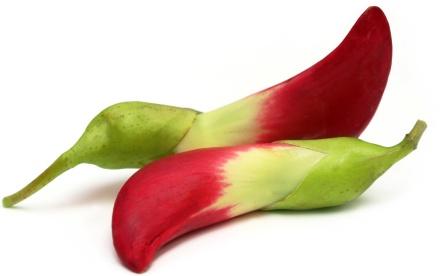
Table of Contents
History of Agastya
Sesbania grandiflora is called such because it produces grand showy large papilionaceous white or cream colored flowers with a tinge of pink in the bud stage. It’s so called as it dared to munis and grows when Agastya star is seen. It’s also said it’s loved by Aghastya derived from agasti the name of a great seer who practiced the rasayana therapies in Himalayas as per advice of god Indra. He was the south Indian representative to learn Ayurveda among eight minis mentioned in charaka Samhita and who controlled vindhya piranha and made it static. He is also the provoker and considered as the former of siddha system of medicine which is highly prevalent in south- west provinces especially in Tamilnadu. His sculptures are found in many temples of Tamilnadu. We can also find the vast usage of Aghastya tree on multiple systems of siddha medicine and Unani also.
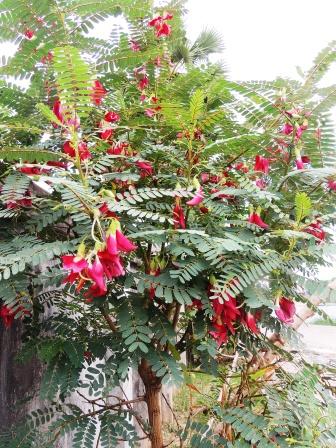
Taxonomical classification
Classification: Source – USDA
| Rank | Scientific Name and Common Name |
| Kingdom | Plantae – Plants |
| Subkingdom | Tracheobionta – Vascular plants |
| Superdivision | Spermatophyta – Seed plants |
| Division | Magnoliophyta – Flowering plants |
| Class | Magnoliopsida – Dicotyledons |
| Subclass | Rosidae |
| Order | Fabales |
| Family | Fabaceae ? Leguminosae –Pea family |
| Genus | Sesbania Scop. – riverhemp |
| Species | Sesbania grandiflora (L.) Poir. |
Qualities, part used, dose
Agastya – Sesbania grandiflora medicinal properties:
Guna (qualities) – Laghu – light to digest, Rooksha – Dryness
Rasa (taste) – Tikta – bitter
Vipaka- Katu – Undergoes pungent taste conversion after digestion
Veerya (potency) – Sheeta – coolant
Effect on Tridosha: Balances Kapha and Pitta Dosha.
Prabhava –Vishaghna – anti toxic
Actions – Netraroghaghna, Jwarahara, Varnya,Kasahara
Pharmacological actions – Hypoglycemic, Cardiac depressant, Anti – inflammatory, Hypotensive
Varieties
Ra. Ni – 4 types based on colour of flower
Sweta – white flower
Pita – Yellow flower
Nila – Blue flower
Rakta – Red flower
According to Bhojana Kutuhalam twelfth chapter, Agastya imparts strength and is cold in potency, sweet in taste, helps in treating psychiatric disorders, cough and vitiation of doshas. The leaves of Agastya treat fatigue, loss of complexion and are not very cold in potency. It is very useful in people suffering from night-blindness and chathurthika fever.
The leaf of red variety of agastya imparts taste, treats toxicity, skin diseases and visarpa. Its flower removes all the sins and its fruit stimulates the digestive fire. It reduces libido, appetizing, dry in nature, aggravates vata and alleviates pitta and kapha dosha.
The tender fruit of Agastya imparts taste, treats vitiation of pitta and kapha doshas and worm infestation. The partially matured fruit helps in the treatment of ophthalmic wounds.
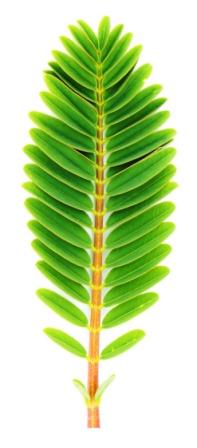
Part used- Bark, Leaves, Flowers, Tender fruits, whole plant.
Dosage- Leaf juice 10-20ml
Decoction – 50-100 ml,
Flower 5-10 g
Morphology
Tall, slender tree
Leaves – Compound, linear -oblong shaped
Inflorescence -Raceme
Flower – White in colour, 2 -4 flowers in one cluster
Fruit – Pod
Useful part – Leaf, Flower, Fruit, Bark, Root
Raw formulations:
Decoction of roots/fruits
Infusion of leaves/flowers
Juice of leaves and flower
Powdered pinching in whole separate
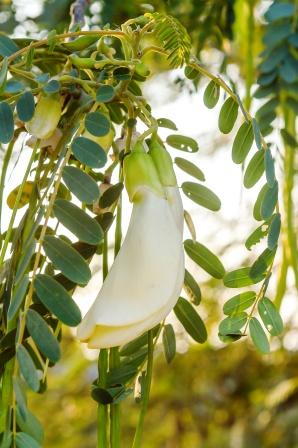
Medicinal uses
Sesbania grandiflora medicinal uses:
Agasti Flower:
Sheeta – coolant
Tikta – bitter
Kashaya – astringent
Katu Vipaka – Undergoes pungent taste conversion after digestion
Indicated in:
Chaturtika Jwara – intermittent fever
Naktandhya – night blindness
Peenasa – rhinitis
Pratishyaya – Running nose, coryza
Shoola – abdominal colic
Pleeha – Spleen related disorders, splenomegaly
Pandu – Anaemia, initial stages of liver disorders
Garavisha – chronic toxicity
Agastya leaves:
Katu – pungent
Tikta – bitter
Guru – heavy
Vishada – non-slimy, clear
Kaphaghna – Balances Kapha Dosha
Sookshma – minuteness
Ushna – hot
Madhura – sweet
Vishaghna – anti-poisonous, anti-toxic
Indicated in:
Krumi – worm infestation (in wounds and in intestines)
Kandu – itching
Shonitapitta – Raktapitta – bleeding disorders like nasal bleeding, Ulcerative colitis and menorrhagia
Fruit is indicated in:
Shosha – dryness, emaciation, weight loss
Gulma – abdominal tumor
Causes increase of Pitta Dosha.
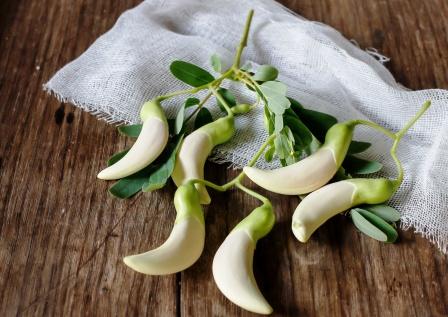
External application
Root and bark paste is applied externally to relieve pain and inflammation associated with arthritis, Gout.
Powdered bark is applied in scabies ulceration of tongue, and alimentary canal.
Leaf juice extract is used for Nasya (nasal drops) to relieve headache, coryza, fever due to Kapha (associated with indigestion and heaviness), and remittent fever.
Leaf juice extract Nasya is also used in the treatment of epilepsy.
The paste of equal quantities of roots of red flowered AGATHI and stomanium is applied to painful swellings and paste of roots in water is applied to rheumatism.
Neurological disorders:
Flowers are used in the treatment of night blindness, headache
Fruits are administered internally to improve memory and intelligence.
Leaves are used as tonic
Fresh juice of leaves or flowers of Agasthya (Sesbania grandiflora) is administered daily in the morning, in the dose of 10-15ml. 5- 10 g powder and decoction 10-20 ml.
Important formulations
Grahani kapata rasa
Pittakasantaka Rasa
Read related – Ayurveda Mahodadhi: Legumes Green Gram, Chickpea, Peas
Sanskrit verse
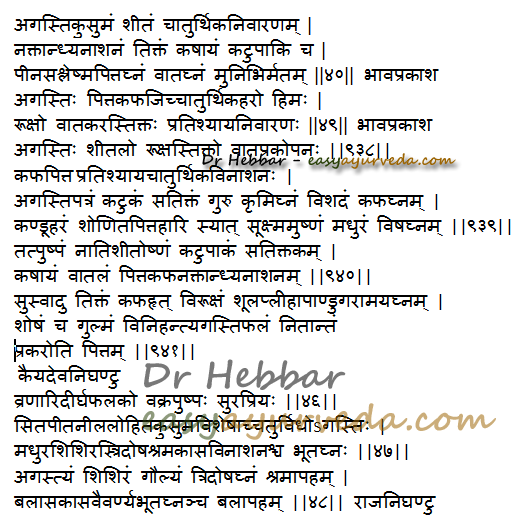
Other uses
Digestive system:
Leaves and flowers are indicated in low digestion strength, constipation, intestinal worms.
Leaves are laxative. Leaf paste is chewed to treat oral and throat infections.
Bark is useful in treating diarrhea and IBS.
Respiratory system: Indicated in bronchitis, cough, cold, coryza
Reproductive system: Flowers are used in treating leucorrhea.
The bark is likely very astringent and given in infusion in the first stage of smallpox and other eruptive fevers.
Bark as a tonic for febrifuge,decoction,taken in small doses in diarrhea and dysentery in large doses it acts as emetic.
In cases of snake bite,the bark of white flower variety grinded with water and administered internally.
The root bark of red flowered variety is useful in vitiated conditions of vata and arthralgia.
An infusion of bark is given in the first stages of smallpox eruptive fevers and malaria.
In NAVA, the bark is used for thrush and infantile disorders of the stomach, bark juice is used in spure, plant is used in gonorrhea and similar urogenital complaints.
The root of red flowered variety rubbed into paste with water is applied in rheumatic swellings, it balances vata, kapha and inflammation. juice of roots with honey given as an expectorant.
Seeds are an emmenagogue. According to the siddha system :- Root ,bark, leaf, flowers are used in food poisoning, pittaja vikaras ,worm infestation, intermittent fever, sinusitis headache, eye diseases, chickenpox, and wasting diseases. According to the Ayurveda system: the root stem flowers, fruit leaves used in body pain, boils, coryza, epilepsy, emaciation, fever, worm infection, hemorrhage, night blindness, promoting memory.
Remedies
Buffalo milk is curdled with the help of flower powder. It is churned to prepare butter. Applied externally to treat cracked foot, roughness and dryness of skin – Bhavaprakasha
Domestic uses of Agasti:
Fresh flowers are traded in the vegetable market at RS.40/kg.
Agastya pushpa sara
Sara – Thin Soup of Flowers of Sesbania grandiflora –
Sara – a classical side dish commonly practiced in Karnataka, Kerala, Maharastra, Tamilnad and Gujarat has classical evidence.
Depending upon the vegetables used, additives added and the flavoring agents incorporated in the preparation it is presented in different manner.
The word meaning of Sara is essence. It is a preparation similar to soup but it is slightly different with respect to pulses and grains which are usually added in Yusha or soups.
As it is devoid of such pulses and grains it appears thin and has the essence of the main ingredient added. Probably it is the reason why it is named as Sara-essence of the ingredient.
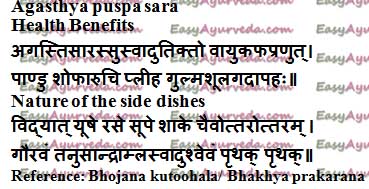
Method of preparation of Agastya flower thin soup – By Dr MS Krishnamurthy MD (Ayu), PhD.
The flowers of Agasthya (Sesbania grandiflora) are taken and the petals are separated.
This is added to water and cooked well.
While cooking turmeric powder, pepper, salt, little jaggery and cumin seeds can also be added. Once boiled properly , it is taken out and served fresh and warm.
Also, as per the need seasoning can also be carried with ghee
Qualities:
Sweet and bitter in taste, balances kapha and vata, good for eyes, appetizer.
Wider utility
It is used in anaemia, inflammatory conditions, anorexia, splenic disorders, gaseous tumors (gulma) and abdominal pain.
Read related – Kadhi Buttermilk soup: Ayurvedic Method Of Making, Health Benefits
As food – the tender leaves pods and flowers are eaten by natives as a vegetable as in curries. When taken freely tend to produce diarrhea, the flowers and fruits are used to prepare pickles, for cattle’s and goats used as fodder.
Domestic use: Wood in Bengal used for posts of native houses and for firewood. In berar and deccan the trees grow as substitutes for bamboo. The species is also used for support for piper vine.
Sacred: The flowers are sacred to Lord Shiva and are supposed to represent the sacredness of reproduction.
Pharmacological activities
CNS depressant, hypertensive, cardiac depressant, diuretic, anti-inflammatory, antibacterial, antipyretic, analgesic, hypoglycemic, cytotoxic activity(human cervical carcinoma) cell line.
Side effects, research
Agastya Side effects:
Agati flowers are contraindicated in Vata imbalance disorders such as neuropathy, bloating, etc,
Research
Anxiolytic and anticonvulsive activity: As per research conducted in College of Pharmacy, Nasik, leaves were evaluated for anti convulsive and anxiolytic properties, experimentally in mice. The research concluded that the triterpene containing a fraction of leaves of S. grandiflora exhibits a wide spectrum of anticonvulsant profile and anxiolytic activity.
Antiproliferative and Apoptotic Effects of Sesbania grandiflora Leaves in Human Cancer Cells:
As per research conducted by Department of Biochemistry and Molecular Biology, School of Life Sciences, Pondicherry University, the alcoholic extract of Agastya exerted anti-proliferative effects especially on lung cancer cells. It followed apoptosis mode of cell death.
Biotin
Biotin or Vitamin B7 is extracted from Sesbania grandiflora. Biotin is useful in treating deficiency disorders such as mal nutrition, rapid weight loss, weak brittle hair and nail, seborrheic dermatitis, diabetes and depression.
Interaction with medicines, supplements
Can this be used while taking Homeopathic medicine?
Yes. This product does not react with homeopathic medicine.
Can this medicine be continued while taking supplements like multivitamin tablets, Omega 3 fatty acids etc?
Yes. Generally, this product goes well with most dietary supplements. However, if you are taking more than one product per day, please consult your doctor for an opinion.
With western
medicines
Seek your
doctor’s advice if you are taking this product along with other western
(allopathic / modern) medicines. Some Ayurvedic herbs can interact with modern
medicine.
If both Ayurvedic and allopathic medicines are advised together, then it is
best to take Allopathic medicine first, wait for 30 minutes and then take the
Ayurvedic medicine.
Ayurvedic medicines
Ayurvedic medicines with Agastya as ingredient:
Ratnagiri Ras – used in the treatment of fever.
Its oil – called Agathi Taila is used as base in the manufacturing of Emulika Oil – AR, by Agrigold Pharmacy, for the treatment of musculo-skeletal disorders.
Usage in Rasashastra
Usage in Rasashastra, Metallurgy, Lohavada:
In special method for preparing lohabhasma: in case or removal of impurities accordant to rasadarpana: Iron and other metals should be smeared with the paste of vidanga and swarasa of agasthi, after impregnating with juice of agasthya, it should be exposed to the sunrays for a long time. This melts away the impurities of the metal as the fire melts the bolus of butter.
In kankushtadi gana in rasachintamani:
herbs quoted are powdered (30) and impregnated with menstrual blood of kakini type women, in addition this should be impregnated with juice of jaya ,decimal, bandhuka, hemapushpa, changeri, dhusara, haridra, and agasti for five times in each. These drugs belong to kankushtadi gana described in rasachintamani.
Nagabhasma Marana:
Earthworm and agasti should be triturated and made to paste. These sheets of lead should be smeared with this paste and cooked by keeping in an iron pan till it melts.
Makshika Shodhana:
Root of shigru should be made into a paste by triturating with juice of agati leaves inside this paste heated makshika should be immersed for purification.
Vajrashodhana – Purification of diamond:
Diamond gets purified in three days with the juice of shyama, shami, dhamarova punarnava, dhoosara, dhusthura, kodrava, akhaparni, agasthi, kunatha, aamlavethasa, meshashrungi, and tuber of surana.
According to rasadarpana preparation of dhruthi:
Flowers paste of agasthya is made with water, mica is added to this paste and kept in the tuber of soorana, and covered liquefied and looks like water.
Sesbania flower, raw
Taste – bitter, astringent
Properties – light, dry
Potency – cold
After digestion taste transformation ( Vipaka ) – pungent
Effect on Doshas
Vata increasing
Pitta balancing
Kapha neutral
Sesbania flower, cooked, steamed, without salt
Taste – bitter, astringent
Properties – light, dry
Potency – cold
After digestion taste transformation ( Vipaka ) – pungent
Effect on Doshas
Vata increasing
Pitta balancing
Kapha balancing (due to increased lightness on cooking)
Sesbania flower, cooked, steamed, with salt
Taste – bitter, astringent, slightly salty
Properties – light, dry
Potency – not very cold (salt is hot in potency)
After digestion taste transformation ( Vipaka ) – pungent
Effect on Doshas
Vata increasing
Pitta nourishing (salt is Pittakara)
Kapha balancing (due to increased lightness on cooking)
Vernacular names
Names in different languages:
English name: Agathi, Vegetable hummingbird, West Indian pea, white dragon tree, August flower, Flamingo Bill, white dragon tree, Swamp pea, sesban, treebean, large flowered agato, west Indian sesban, brede malabar, mascaraing’s, corkwood trees, west Indian pea, fabaceace agati
Hindi name- Agastha, Agasti, basma, chogache, (gaach-munga), Aghastya, agast, hathya, basna, hadga, bakapushpa, vakrapushpa, agathiya, sadabasna,
Kannada name – Agase, agache, kempagase, chogache, vakrapushpi, agasi, chogachi, agase soppu
Tamil name- Agati
Malayalam name – (akatti), aagatti, atti, argatti, akatti, athi, agatti
Telugu name- Avisa, Avishi
Oriya name – (agastee)
Gujarati name – Agathiyo,ayathio,agath-thi-nar
Bengali name – Bak, Bagphal, Bak, basnapul, vak, agashi, basna, vasna, heta, agasti, agustua, bagfal, buka, bukao, Bangfal.
Filipino name – gauai-gauai,
French name – Pois Valette
Indonesian name – Toroy
Nepali name – Agasti
Sinhalese name – Kathuru
Berar name – Hadga, hela, bisna, bako
Burmese name – Paukhya, paukpan
Cambodia – Angkea day
Sanskrit Synonyms
Vangasena – Found in Bengal region
Agasti, Agastya – Flowers blossomin Agastya star day of Sharat Rutu (Autumn)
Agasti
Munipushpa, Munidruma – Plant flowers when Agasthya star seen in sky
Munivriksha, Siddha, Panktipatra, Mridusimbi, Maharuha, Vakrapushpa – It has curved flowers
Vranari – Useful in wounds
Dirgaphalaka, Surapriya,
Kumbhayoni, Kopachera, Sheeghrapushpa,
Madhushigruka, Madhuryati
Types, habitat
Types: As per Raja Nighantu, there are four types of Agastya, based on colour of flower. –
Sita – white
Peeta – yellow
Neela – blue
Lohita – red
Habitat:
The native is said as Malaysia and is grown in many parts of India such as Punjab ,Delhi, Assam, Bengal, Andaman, Karnataka,Tamilnadu and in many parts of India.
Description
A soft wooded medium-sized tree up to 6 to 6.2 meters height with smooth light brown bark, wood white soft. Leaflets linear, oblong, glabrous. Flowers large, white or red. Pods long, curved, Pendulous.
Flowering and fruiting time
February to March; cold and spring season.
Varieties
Four kinds of plants based on flower color.
White (Sveta), yellow (pita), blue (nila) and red (rakta) in classical texts of Materia medica.
Classical categorisation
Sushruta – Mentioned it in vishista drava dravya vignanam (special group of herbs and liquids)
Bhavaprakasha – Shaka varga, Pushpavarga
Kaiyadeva Nighantu – Oshadhi Varga
Raja Nighantu – Karaveeradi Varga, PraBhadradi varga
Astanga hrudaya – mentioned it in Naktandhya Chikitsa (treatment for night blindness)
Shodala nigantu – Aushadha varga
Nigantu aadarsha – Poorvardha-palashaadhi varga
Vaidhya manorama – Majjavaha srotho vikara
Madhava drayagunadarsha – Vanaushadha varga
Bhaavaprakasha(haritakyadi nighantu) – Pushpavarga
Bruhad nigantu rathnakara – Pushpa varga
Dhanvantari nigantu – Aushadha varga
Chemical composition
Sesbania grandiflora chemical composition:
Flowers – Methyl oleanolate
Seeds – Kaempferol, leucocyanidin
Other constituents are – arginine, cysteine, histidine, phenylalanine, tryptophan, asparagine, aspartic acid, oleanolic acid, galactose, Rhamnose & glucuronic acid.
Leaves: contain saponin oleanolic acid galactose ramose and glucuronic acid, grandiferol floral custin Histidine isoleucine phenyl amine Tryptophan valine threonine alanine asparagine aspartic acid.
Sthanika karma (Systemic Acton)
Externally – Leaf and bark can be useful in edematous conditions. Leaf paste indicated in wounds. It cleanses the wound and promotes wound healing. Leaf juice helps to expel out morbid doshas from the upper part of the neck (Siro virechana). It is indicated in Headache, Rhinitis, Fever due to kapha origin etc.
Internally
Nervous System – Promote intellect, Helps to regain consciousness, good for eyes. Root and bark paste is beneficial in Rheumatic joint complaints. Its Flower and leaf is indicated in Cataract, night blindness, etc. good to improve eyesight.
Digestive system – Flower and Leaves has Carminative, digestive, absorbent and Anthelminthic action. Indicated in loss of appetite, abdominal disorders, diarrhea, malabsorption syndrome etc.
Circulatory System – Raktapitta samaka.
Respiratory System –Leaf, Flower and Bark help to expel excessive kapha from the respiratory tract. Indicated in Inflammation of respiratory passage, cough, rhinitis etc. Bark juice with honey can be given in such conditions.
Excretory system – indicated in Urinary infection.
Skin – Facilitate sweat production, Indicated in skin boils etc.
Indicated in fever (vishama jvara, Kapha jvara, Chaturthaka jvara, Sannipata jvara)
Satmikarana – Ant poisonous











3 comments
anil
Hello doc,
I just have a quick question. I have started giong to thy gym at 5 in the moring, before school. After the workout I need to eat something, obviously, and I was wondering if eating fruits only is ok, like dates, raisins and apples mainly.
Or are there better solutions?
Dr J V Hebbar MD(Ayu)Author
Hi, dates, raisins and apples look the better option after workout.
anil
So they are good and effective?
I am on the go, so I cant really take anything else.
But I still want my afterworkout-food to benefit.